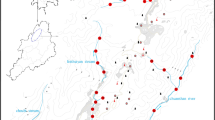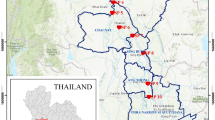Abstract
From data collected monthly at 26 monitoring cross sections in the Wei River in the Shaanxi Region of China during the period 2008–2012, the temporal pollution characteristics of heavy metals (Hg, Cd, Cr(VI), Pb, and As) were analyzed based on a heavy metal pollution index (HPI). The monthly HPI values of the five heavy metals in the river fluctuated greatly in 2008 and then declined gradually with time. This general trend of reduction in HPI appears not to have a seasonal variation and most likely resulted from the continued improvement in heavy metal pollution control strategies implemented by local environmental agencies combined with a significant improvement in wastewater treatment capacities. Among the five heavy metals, Cd and Pb were below 0.1 and 3 μg L−1, respectively, at all the sampling points in the studied areas in the year 2012. The detection rates of As, Hg, and Cr(VI) were in the order of Hg > Cr(VI) > As. Hg, Cr(VI), and As exceeded, in a month of the dry season in 2012, the standard limits for category III surface waters according to the China Environment Quality Standards for Surface Water (CEQSSW). Based on the assessment using the HPI method, the pollution status of these heavy metals in water of the Wei River in the Shaanxi Region was generally at an acceptable level, but exhibited distinctive characteristics between the main stream river and tributaries. Most of the tributaries were more seriously polluted than the main river. A health risk assessment was conducted based on the Human Health Risk Assessment (HHRA) method recommended by the United States Environmental Protection Agency (USEPA). Apart from As, the health risk for the five heavy metals in the region were at acceptable levels for drinking water sources (hazard quotient (HQ) < 1, carcinogenic risk (CR) ranged from 10−4–10−6) according to the Risk Assessment Guidance for Superfund (RAGS), USEPA. Arsenic was identified as the most important pollutant of concern among the five heavy metals; both its values of the HQ and CR indicated potentially adverse health risks for the local population.




Similar content being viewed by others
Explore related subjects
Discover the latest articles, news and stories from top researchers in related subjects.References
Akinci, G., Guven, D. E., & Ugurlu, S. K. (2013). Assessing pollution in Izmir Bay from rivers in western Turkey: heavy metals. Environmental Science: Processes & Impacts, 15(12), 2252–2262.
APHA, AWWA, & WEF. (1996). Standard methods for the examination of water and wastewater, 19th ed (19th ed.). Washington: American Public Health Association, American Water Works Association, Water Environment Federation.
Chang, C. Y., Yu, H. Y., Chen, J. J., Li, F. B., Zhang, H. H., & Liu, C. P. (2014). Accumulation of heavy metals in leaf vegetables from agricultural soils and associated potential health risks in the Pearl River Delta, South China. Environmental Monitoring and Assessment, 186(3), 1547–1560.
Davutluoglu, O. I., Seckin, G., Ersu, C. B., Yilmaz, T., & Sari, B. (2011). Heavy metal content and distribution in surface sediments of the Seyhan River, Turkey. Journal of Environmental Management, 92(9), 2250–2259.
Environmental Protection Agency, U. S., & USEPA. (2004). Risk assessment guidance for superfund, volume I: human health evaluation manual (Part E, supplemental guidance for dermal risk assessment). EPA/540/R/99/005. Washington: Office of Emergency and Remedial Response.
Environmental Protection, U. S., & Agency, USEPA. (1989). Risk assessment guidance for superfund, volume 1: human health evaluation manual (part A). EPA/540/1-89/002. Washington: Office of Emergency and Remedial Response.
Gaur, N., Flora, G., Yadav, M., & Tiwari, A. (2014). A review with recent advancements on bioremediation-based abolition of heavy metals. Environmental Science: Processes & Impacts, 16(2), 180–193.
Guan, J. L., Wang, L., Pei, X. L., Yang, Y. Z., Xing, Y., & Liu, Y. (2012). Trends of major pollutants found in Weihe River in Shaanxi Province. Bulletin of Soil and Water Conservation, 32(6), 51–54.
Guney, M., Zagury, G. J., Dogan, N., & Onay, T. T. (2010). Exposure assessment and risk characterization from trace elements following soil ingestion by children exposed to playgrounds, parks and picnic areas. Journal of Hazardous Materials, 182(1), 656–664.
Guo, W. (2010). Water quality trend analysis of the main control sections of Wei River reaches in Shaanxi Province. Safety and Environmental Engineering, 17(5), 47–50.
Guo, W. (2011). Integrated evaluation of water quality and quantity in Weihe River reach of Shaanxi Province. Journal of Water Resources and Water Engineering, 22(5), 115–125.
He, B., Yun, Z. J., Shi, J. B., & Jiang, G. B. (2013). Research progress of heavy metal pollution in China: sources, analytical methods, status, and toxicity. Chinese Science Bulletin, 58(2), 134–140.
International Agency for Research on Cancer, IARC. (2013). Agents classified by the IARC monographs, Vol. 1–109. http://monographs.iarc.fr/ENG/Classification/index.php/. Accessed November 2013.
Kelderman, P., & Osman, A. A. (2007). Effect of redox potential on heavy metal binding forms in polluted canal sediments in Delft (The Netherlands). Water Research, 41(18), 4251–4261.
Khan, K., Lu, Y. L., Khan, H., Zakir, S., Ihsanullah, N. O., Khan, S., Khan, A. A., Wei, L., & Wang, T. Y. (2013). Health risks associated with heavy metals in the drinking water of Swat, northern Pakistan. Journal of Environmental Sciences, 25(10), 2003–2013.
Kim, E., Little, J. C., & Chiu, N. (2004). Estimating exposure to chemical contaminants in drinking water. Environmental Science & Technology, 38, 1799–1806.
Kohušová, K., Havel, L., Vlasák, P., & Tonika, J. (2011). A long-term survey of heavy metals and specific organic compounds in biofilms, sediments, and surface water in a heavily affected river in the Czech Republic. Environmental Monitoring and Assessment, 174(1–4), 555–572.
Lee, J., Pedersen, A. B., & Thomsen, M. (2013). Framework for combining REACH and national regulations to obtain equal protection levels of human health and the environment in different countries—comparative study of Denmark and Korea. Journal of Environmental Management, 125, 105–116.
Lester, J. N. (1983). Significance and behaviour of heavy metals in waste water treatment processes I. Sewage treatment and effluent discharge. Science of the Total Environment, 30, 1–44.
Li, S., & Zhang, Q. (2010). Risk assessment and seasonal variations of dissolved trace elements and heavy metals in the Upper Han River, China. Journal of Hazardous Materials, 181(1), 1051–1058.
Li, J. K., Li, H. E., Shen, B., & Li, Y. J. (2011). Effect of non-point source pollution on water quality of the Weihe River. International Journal of Sediment Research, 26(1), 50–61.
Li, Z. Y., Ma, Z. W., Van der Kuijp, T. J., Yuan, Z. W., & Huang, L. (2014). A review of soil heavy metal pollution from mines in china: pollution and health risk assessment. Science of the Total Environment, 468, 843–853.
Miguel, E. D., Iribarren, I., Chacón, E., Ordoñez, A., & Charlesworth, S. (2007). Risk-based evaluation of the exposure of children to trace elements in playgrounds in Madrid (Spain). Chemosphere, 66(3), 505–513.
Ouyang, Y., Nkedi-Kizza, P., Wu, Q. T., Shinde, D., & Huang, C. H. (2006). Assessment of seasonal variations in surface water quality. Water Research, 40(20), 3800–3810.
Reza, R., & Singh, G. (2010). Heavy metal contamination and its indexing approach for river water. International Journal of Environmental Science and Technology, 7(4), 785–792.
Shaanxi Province Environmental Monitoring Center, SPEMC. (2012). Environmental statistics of Shaanxi province.
Song, J. X., Xu, Z. X., Liu, C. M., & Li, H. E. (2007). Ecological and environmental instream flow requirements for the Wei River—the largest tributary of the Yellow River. Hydrological Processes, 21(8), 1066–1073.
State Environmental Protection Administration of China, SEPAC. (2002a). Monitoring and analysis methods for water and wastewater (4th ed.). Beijing: China Environmental Science Press.
State Environmental Protection Administration of China, SEPAC. (2002b). Environment quality standards for surface water (GB3838-2002). http://kjs.mep.gov.cn/hjbhbz/bzwb/shjbh/shjzlbz/200206/W020061027509896672057.pdf. Accessed November 2013.
US Department of Energy, USDOE. (2013). The risk assessment information system (RAIS). http://rais.ornl.gov/tutorials/whatisra.html. Accessed November 2013.
US Environmental Protection Agency, USEPA. (2000). Risk characterization handbook. EPA 100-B-00-002. Accessed November 2013.
US Environmental Protection Agency, USEPA. (2012). 2012 Edition of the drinking water standards and health advisories. EPA 822-S-12-001. Accessed November 2013.
US Environmental Protection Agency, USEPA. (2013). Regional screening level (RSL) summary Table. http://www.epa.gov/reg3hwmd/risk/human/rb-concentration_table/Generic_Tables/docs/master_sl_table_run_NOV2013.pdf. Accessed November 2013.
Van Hook, R. I. (1979). Potential health and environmental effects of trace elements and radionuclides from increased coal utilization. Environmental Health Perspectives, 33, 227–247.
Wanda, E. M. M., Gulula, L. C., & Phiri, G. (2012). Determination of characteristics and drinking water quality index in Mzuzu City, Northern Malawi. Physics and Chemistry of the Earth, 50, 92–97.
Wang, Y., & Huang, Y. M. (2007). Research progress of heavy metals in water environment of China. Carcinogenesis, Teratogenesis & Mutagenesis, 19, 198–202.
World Health Organization, WHO. (1993). Guidelines for drinking-water quality - vol. I: recommendations, 2nd ed. http://www.who.int/water_sanitation_health/dwq/gdwq3rev/en/. Accessed November 2013.
World Health Organization, WHO. (2008). Guidelines for drinking-water quality- vol. I: recommendations, Third ed. http://www.who.int/water_sanitation_health/dwq/GDW8rev1and2.pdf. Accessed November 2013.
Wu, B., Zhao, D. Y., Jia, H. Y., Zhang, Y., Zhang, X. X., & Cheng, S. P. (2009). Preliminary risk assessment of trace metal pollution in surface water from Yangtze River in Nanjing Section, China. Bulletin of Environmental Contamination and Toxicology, 82(4), 405–409.
Zhai, M., Lu, X. W., Huang, L., Wang, L. J., & Lei, K. (2010). Particle size distribution and pollution assessment of heavy metals in the surface sediment from Yangling to Xingping reach of the Wei River. Journal of Shaanxi Normal University (Natural Science Edition), 38, 94–98.
Acknowledgments
Financial support from the Special Research Program Development Foundation of Shaanxi, China (DB03087) is gratefully acknowledged.
Author information
Authors and Affiliations
Corresponding author
Electronic supplementary material
Below is the link to the electronic supplementary material.
ESM 1
(DOC 136 kb)
Rights and permissions
About this article
Cite this article
Yang, X., Duan, J., Wang, L. et al. Heavy metal pollution and health risk assessment in the Wei River in China. Environ Monit Assess 187, 111 (2015). https://doi.org/10.1007/s10661-014-4202-y
Received:
Accepted:
Published:
DOI: https://doi.org/10.1007/s10661-014-4202-y




